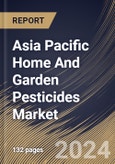Pesticide formulations are designed to effectively target and control specific pests while minimizing harm to non-target organisms and the environment. Formulations may include active ingredients that disrupt pests' physiological processes or behaviours, leading to their elimination or suppression. Formulations that demonstrate high efficacy and reliability in pest control are favoured by consumers and drive market growth.
Pesticide formulations offer versatility in application methods, catering to various pest control needs and preferences. Liquid formulations, such as emulsifiable concentrates (EC) and ready-to-use (RTU) sprays, are commonly used for foliar applications on plants and surfaces. Granular formulations are applied to soil for systemic pest control, while dust and baits target pests in specific locations. The availability of diverse formulation options allows consumers to choose products that best suit their pest control requirements.
Integrated pest management (IPM) strategies, which prioritize non-chemical control methods, monitoring, and prevention, are supported by regulatory agencies and authorities to decrease reliance on chemical pesticides. Technological innovations in pesticide formulations, application methods, and pest monitoring systems are revolutionizing the market, offering consumers a wider range of effective and environmentally friendly options. The market boasts various pest control products, including insecticides, herbicides, fungicides, and rodenticides, available in various formulations such as sprays, granules, baits, and traps.
The demand for home and garden pesticides is also increasing because of their wider availability on online channels. The growth of online retail sales and retail sales of consumer goods in China signifies a growing market driven by increased consumer spending, accessibility to products in rural areas, and opportunities for market expansion and innovation. According to the Shanghai Municipal People's Government, in the January-June period (2023), online retail sales nationwide hit 7.16 trillion yuan (US$1 trillion), up 13.1 percent yearly. In the first half of the year, online retail sales in rural China increased 12.5% annually, 3.7 percentage points quicker than in the initial quarter. Hence, the growth of the e-commerce sector and the rising chemical industry in the region propel the market's growth.
The China market dominated the Asia Pacific Home And Garden Pesticides Market by Country in 2022, and would continue to be a dominant market till 2030; thereby, achieving a market value of $913 Million by 2030. The Japan market is exhibiting a CAGR of 6% during (2023 - 2030). Additionally, The India market would experience a CAGR of 7.4% during (2023 - 2030).
Based on Application, the market is segmented into Garden and Household. Based on Formulation, the market is segmented into Liquid and Powder. Based on Distribution Channel, the market is segmented into Offline and Online. Based on Type, the market is segmented into Herbicides, Insecticides, Fungicides and Fumigants. Based on countries, the market is segmented into China, Japan, India, South Korea, Australia, New Zealand, and Rest of Asia Pacific.
List of Key Companies Profiled
- BASF SE
- Central Garden & Pet Company
- Bayer AG
- Syngenta AG Group
- Reckitt Benckiser Group PLC
- DuPont de Nemours, Inc.
- Sumitomo Chemical Co., Ltd.
- Willert Home Products
- S.C. Johnson & Son, Inc.
- The Scotts Miracle-Gro Company
Market Report Segmentation
By Application- Garden
- Household
- Liquid
- Powder
- Offline
- Online
- Herbicides
- Insecticides
- Fungicides
- Fumigants
- China
- Japan
- India
- South Korea
- Australia
- New Zealand
- Rest of Asia Pacific
Table of Contents
Companies Mentioned
- BASF SE
- Central Garden & Pet Company
- Bayer AG
- Syngenta AG Group
- Reckitt Benckiser Group PLC
- DuPont de Nemours, Inc.
- Sumitomo Chemical Co., Ltd.
- Willert Home Products
- S. C. Johnson & Son, Inc.
- The Scotts Miracle-Gro Company
Methodology

LOADING...








